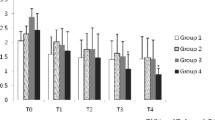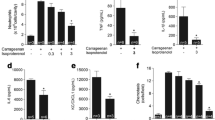Abstract
To investigate the role of glutathione (GSH) on prostaglandin (PG) synthesis, isolated rabbit spleens were perfused with Tyrode's solution with or without the addition of diethyl maleate (DEM) in concentrations up to 1 mM. In the absence of DEM, PG synthesis was stimulated by the Ca2+ ionophore A23187 (20 nmole) or arachidonate (0.4 μmole). Prostaglandin (PG) E2 was a major product, accounting for 60–70% of the total cyclooxygenase products. Small amounts of PGF2α, 6-keto-PGF1α, PGD2 and thromboxane (Tx) B2 were also produced. When DEM was added to the perfusion medium, GSH content decreased dose-dependently with increasing DEM concentration. Lactate dehydrogenase activity was not detected in the venous effluent, indicating that DEM depleted intrasplenic GSH without causing any lysis of cellular membranes. A23187-induced production of PGs and of Tx was decreased with increasing concentrations of DEM up to 0.5 mM, whereas at 1.0 mM DEM, these products showed a tendency to increase as compared with levels at 0.5 mM DEM. However, this increase was only significant for TxB2, which returned to levels obtained in the absence of DEM. DEM 1 mM did not cause cell lysis, but it appears to perturb the cell membrane to a degree similar to that which occurs with stimulation of phospholipase A2. The small but significant increase of TxB2 with 1.0 mM DEM could be a result of decreased PGE2 isomerase activity. Perfusion with arachidonate gave virtually identical results: 1.0 mM DEM attenuated the production of all prostanoids except for TxB2 as compared with untreated controls. These results suggest that GSH contributes to the regulation and/or maintenance of PGs synthesis.
Similar content being viewed by others
References
Bergmeyer HU, Kreutz FH, Pilz W, Schmidt, FW, Bü, Lang H, Rick W, Stamm D, Hillmann G, Laue D, Schmidt E, Szasz G (1970) Empfehlungen der Deutschen Gesellschaft für klinische Chemie. Z Klin Chem Klin Biochem 8: 658–660 or ibid. 10: 182–192 (1972)
Boyland E, Chasseaud LF (1970) The effect of some carbonyl compounds on rat liver glutathione levels. Biochem Pharmacol 19: 1526–1528
Chance B, Boveris A, Nakase Y and Sies H (1978) Hydroperoxide metabolism: An overview. In: Sies H, Wendel A (ed) Functions of glutathione in liver and kidney, Springer, New York, pp 95–106
Christophersen BO (1968) Formation of monohydroxy-polyenic fatty acids from lipid peroxides by a glutathione peroxidase. Biochim Biophys Acta 164: 35–46
Christophersen BO (1969) Reduction of linolenic acid hydroperoxide by a glutathione peroxidase. Biochim Biophys Acta 176: 463–470
Egan RW, Gale PH, Kuehl FA Jr (1979) Reduction of hydroperoxides in the prostaglandin biosynthetic pathway by a microsomal peroxidase. J Biol Chem 254: 3295–3302
Egan RE, Paxton J, Kuehl FA Jr (1976) Mechanism for irreversible self-deactivation of prostaglandin synthetase. J Biol Chem 251: 7329–7335
Eling TE, Curtis JF, Harman LS, Mason RP (1986) Oxidation of glutathione to its thiyl free radical metabolite by prostaglandin synthase. J Biol Chem 261: 5023–5028
Fridovich I (1978) The biology of oxygen radicals. Science 201: 875–880
Haenen GRMM, Bast A (1983) Protection against lipid peroxidation by a microsomal glutathione-dependent labile factor. FEBS Lett 159: 24–28
Hidaka T, Malik KU (1980) Release of prostaglandins evoked by neurohormonal stimuli in the isolated spleen of rabbit. Eur J Pharmacol 62: 97–105
Hidaka T, Wong PY-K, Malik KU (1980) Metabolism of [14C] arachidonic acid in the isolated rabbit spleen. Prostaglandins 19: 805–818
Kosower NS, Kosower EM (1979) The glutathione status of cells. Int Rev Cytol 54: 109–160
Ku RH, Billings RE (1986) The role of mitochondrial glutathione and cellular protein sulfhydryls in formaldehyde toxicity in glutathione-depleted rat hepatocytes. Arch Biochim Biophys 247: 183–189
Little C, O'Brien J (1968) An intracellular GSH-peroxidase with a lipid peroxide substrate. Biochem Biophys Res Commun 31: 145–150
Mitchell JR, Jollow DJ, Potter WZ, Gillette JR, Brodie BB (1973) Acetaminophen-induced hepatic necrosis. IV. Protective role of glutathione. J Pharmacol Exp Ther 187: 211–217
Ogino N, Miyamoto T, Yamamoto S, Hayaishi O (1977) Prostaglandin endoperoxide E isomerase from bovine vesicular gland microsomes, a glutathione-requiring enzyme. J Biol Chem 252: 890–895
Ohki S, Ogino N, Yamamoto S, Hayaishi O (1979) Prostaglandin hydroperoxidase, an integral part of prostaglandin endoperoxide synthetase from bovine vesicular gland microsomes. J Biol Chem 254: 829–836
Ormstad K, Jones DP, Orrenius S (1980) Characteristics of gluta-thione biosynthesis by fleshly isolated rat kidney cells. J Biol Chem 255: 175–181
Tientze F (1969) Enzymic method for quantitative determination of nanogram amounts of total and oxidized glutathione: applications to mammalian blood and other tissues. Anal Biochem 27: 502–522
Author information
Authors and Affiliations
Rights and permissions
About this article
Cite this article
Hidaka, T., Furuno, H., Inokuchi, T. et al. Effects of diethyl maleate (DEM), a glutathione depletor, on prostaglandin synthesis in the isolated perfused spleen of rabbits. Arch Toxicol 64, 103–108 (1990). https://doi.org/10.1007/BF01974394
Received:
Revised:
Accepted:
Issue Date:
DOI: https://doi.org/10.1007/BF01974394




